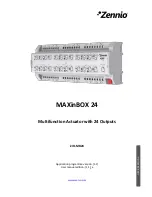9.3.5.4 Analog Peripheral Power Selection
The analog peripherals (e.g., ULFRCO, LFRCO, LFXO, HFRCO, AUXHFRCO, VMON, IDAC, ADC) may be powered from one of two
supply pins, depending on the configuration of the ANASW bit in the EMU_PWRCTRL register: Changes to the ANASW setting should
be made immediately out of reset (i.e., in the Startup Configuration) before all clocks (with the exception of HFRCO and ULFRCO) are
enabled. Once ANASW is configured it should not be changed. Note that the flash is always powered from the AVDD pin, regardless of
the state of the ANASW bit.
Table 9.4. Analog Peripheral Power Configuration
ANASW
Analog Peripheral Power Source
Comments
0 (default)
AVDD pin
This configuration may provide a quieter supply to the analog mod-
ules, but is less efficient as AVDD is typically at a higher voltage than
DVDD.
1
DVDD pin
This configuration may provide a noisier supply to the analog mod-
ules, but is more efficient.
9.3.5.5 IOVDD Connection
The IOVDD can be connected to either the DCDC Output (V
DCDC
) or the main supply.
Note that when IOVDD is powered from the V
DCDC
, any circuit attached to IOVDD must be capable of withstanding the main supply
voltage momentarily. This is because at startup, the bypass switch is on, shorting the main supply to V
DCDC
. In addition, the system
must take into consideration the maximum allowable DCDC load current. Refer to datasheet for DCDC specification.
IOVDD must be less than or equal to AVDD.
9.3.5.6 DC-to-DC Programming Guidelines
Note:
Refer to Application Note AN0948: "Power Configurations and DC-DC" for detailed information on programming the DC-DC. Ap-
plication Notes can be found on the Silicon Labs website (www.silabs.com/32bit-appnotes) or using the [
Application Notes
] tile in Sim-
plicity Studio.
9.3.6 Brown Out Detector (BOD)
9.3.6.1 AVDD BOD
The EFM32 Jade Gecko has a fast response Brown Out Detector (BOD) on AVDD that is always active. This BOD ensures the minimal
supply is provided to the AVDD supply (typically also connected to VREGVDD). Once triggered, the BOD will cause the system to reset.
Note:
In EM4 Hibernate/Shutoff a low power version of the AVDD BOD, called EM4BOD, is available to trigger a reset at level lower
than in other energy modes. All other BOD's are disabled during EM4 Hibernate/Shutoff
9.3.6.2 DVDD and DECOUPLE BOD
Additional BODs will monitor DVDD and DECOUPLE during EM0 Active through EM3 Stop. This can cause a reset to the internal logic,
but will not cause a power-on reset or reset the EMU or RTCC.
EFM32JG1 Reference Manual
EMU - Energy Management Unit
silabs.com
| Smart. Connected. Energy-friendly.
Preliminary Rev. 0.6 | 168


















